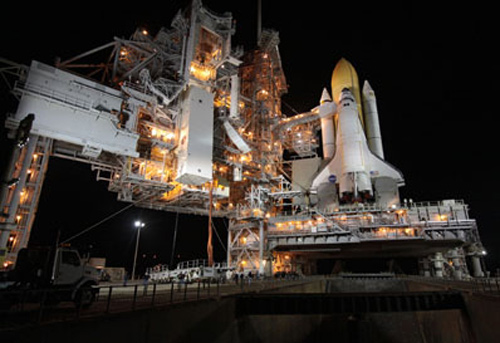Astronauts Ready for Shuttle Launch Amid NASA Uncertainty

WASHINGTON – Six NASA astronauts are ready to rocket into space on the shuttle Endeavour in just over a week as questions swirl over the impact of the space agency’s upcoming budget request.
Endeavour commander George Zamka said Friday that he and his crew are completely focused on the planned Feb. 7 launch to the International Space Station. Their mission: to deliver a new room to the $100 billion orbiting lab that will leave it nearly complete.
The shuttle is scheduled to blast off from NASA’s Kennedy Space Center in Cape Canaveral, Fla., before dawn on Feb. 7 at 4:39 a.m. EST (0939 GMT), making it the last planned night launch of Endeavour or any other orbiter. The launch will come six days after NASA rolls out its new spending goals for the next fiscal year – a plan that may depart substantially from the agency’s earlier human spaceflight goals.
But Endeavour’s astronauts have had no time to dwell on the agency’s long-range plan. Not with blastoff less than 10 days away.
“There’s a space shuttle with 4 million pounds of propellant and an international payload strapped to it, and thousands of bits of hardware to handle, all with our name on it at Pad 39A at the Cape,” Zamka told reporters in a briefing. “We’ve been preparing ourselves for this mission for a year, and arguably we’ve been preparing for it for most of our lives. And we get one chance to get it right.”
Zamka’s five-man, one-woman crew is about to embark on the first of NASA’s five final shuttle missions before the agency retires its three-orbiter fleet later this year. The planned 13-day mission will deliver a brand-new room – the Tranquility module – and a long-awaited observation portal for the International Space Station.
Named after the first moon base established by Apollo 11 astronauts in 1969, Tranquility is the last large piece of NASA’s section of the space station to fly. Its arrival will leave the outpost 90 percent complete after more than 11 years of space construction.
Breaking space news, the latest updates on rocket launches, skywatching events and more!
“We’ve got a great mission in front of us and we’re very anxious to get started,” Zamka said. Three spacewalks are planned for the spaceflight.
Zamka said he and his crew have heard in vague terms the issues surrounding announcement of NASA’s fiscal year 2011 budget request, which is due to be rolled out at NASA headquarters in Washington, D.C., on Monday. Early reports suggest that President Barack Obama’s budget request for NASA would boost the agency’s budget by $6 billion over the next five years, but also scrap the agency’s current effort to send astronauts on new moon landing missions by 2020.
NASA plans to replace Endeavour and its sister ships Discovery and Atlantis with new Orion crew capsules designed to launch atop new Ares rockets as part of its Constellation program. The Obama budget request would direct NASA to invest heavily into American commercial spacecraft development to fly astronauts to and from the International Space Station after the shuttle fleet retires, according to the early reports.
NASA has been flying space shuttle missions since April 1981. Endeavour's flight will be the 130th shuttle mission when it launches.
While Endeavour astronauts were hesitant to comment on the changes ahead for NASA, they did say that they have been contemplating the shuttle’s looming retirement this year.
Veteran astronaut Stephen Robinson, who will make his fourth trip to space on the upcoming mission, said that while the shuttle era is ending, it is leaving a giant, gleaming space laboratory behind as its legacy.
“How could you feel anything but thrilled and very proud to have done something like that,” Robinson said.

Tariq is the award-winning Editor-in-Chief of Space.com and joined the team in 2001. He covers human spaceflight, as well as skywatching and entertainment. He became Space.com's Editor-in-Chief in 2019. Before joining Space.com, Tariq was a staff reporter for The Los Angeles Times covering education and city beats in La Habra, Fullerton and Huntington Beach. He's a recipient of the 2022 Harry Kolcum Award for excellence in space reporting and the 2025 Space Pioneer Award from the National Space Society. He is an Eagle Scout and Space Camp alum with journalism degrees from the USC and NYU. You can find Tariq at Space.com and as the co-host to the This Week In Space podcast on the TWiT network. To see his latest project, you can follow Tariq on Twitter @tariqjmalik.
